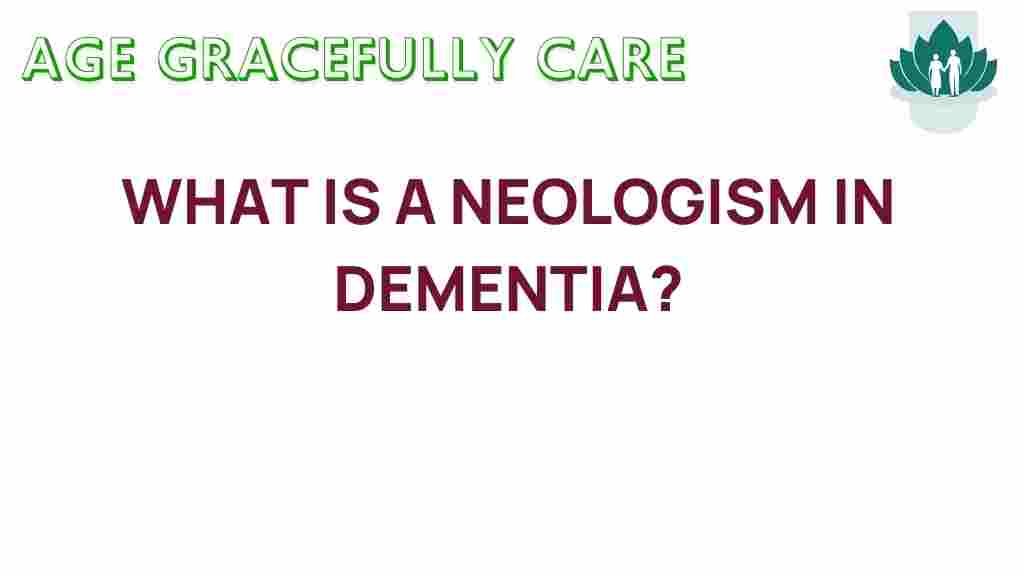Unraveling Neologisms: The Hidden Language of Dementia Patients
Dementia is a complex condition that affects not only memory but also language and communication. One intriguing aspect of dementia is the phenomenon of neologism, where patients create new words or use existing words in unusual ways. Understanding this unique form of communication is essential for caregivers, family members, and healthcare professionals. In this article, we will explore the connection between neologism and dementia, the implications for communication, and how to enhance care through better understanding.
What Are Neologisms?
Neologisms are newly coined terms or expressions that may not be widely recognized or understood. In the context of dementia, neologisms often emerge as a result of cognitive decline, affecting the individual’s ability to retrieve the correct words. This can lead to the creation of nonsensical words or phrases that may seem perplexing to those around them.
The Connection Between Neologism and Dementia
As dementia progresses, various cognitive functions deteriorate, influencing language abilities. The emergence of neologisms can be attributed to:
- Language Retrieval Issues: Dementia can impair an individual’s ability to recall familiar words, leading them to substitute with made-up terms.
- Impaired Cognition: Cognitive decline affects the brain’s ability to process language, resulting in creative but nonsensical expressions.
- Emotional Expression: Sometimes, neologisms might be used to convey emotions or thoughts that the patient feels are best described through their invented terms.
Understanding Neologisms in Communication
Effective communication is crucial for dementia patients to express their needs and feelings. While neologisms may seem confusing, they can also hold significance. Here are ways to enhance understanding:
- Listen Actively: Pay attention to the context in which the neologism is used. The surrounding conversation may provide clues to its meaning.
- Encourage Expression: Allow patients to express themselves freely, even if they use neologisms. This fosters a sense of dignity and self-worth.
- Ask Clarifying Questions: Gently ask for clarification about their neologisms to engage them in conversation and show that you are interested.
Recognizing Symptoms of Language Changes in Dementia
As dementia progresses, individuals may exhibit a range of symptoms that affect language and communication:
- Word-Finding Difficulty: Patients may struggle to find the right words, resulting in pauses or substitutions.
- Repetitive Speech: Repeating the same phrases or questions can become common.
- Reduced Vocabulary: A noticeable decline in the variety of words used can occur.
- Confused Syntax: Sentence structure may become jumbled or illogical.
The Impact of Neologisms on Care
Understanding neologisms can significantly improve the quality of care provided to dementia patients. Here are some strategies:
- Training Caregivers: Educate caregivers about neologisms and the importance of context in communication.
- Building a Communication Bridge: Use visuals, gestures, or familiar objects to help decipher neologisms.
- Creating a Safe Environment: Foster an environment where patients feel comfortable expressing themselves, even if their language seems unconventional.
Step-by-Step Process to Enhance Communication with Dementia Patients
Enhancing communication with dementia patients involves a thoughtful approach:
- Establish Rapport: Build a trusting relationship with the patient through consistent interactions.
- Use Simple Language: Speak clearly and use simple, familiar words to minimize confusion.
- Incorporate Non-Verbal Cues: Utilize body language, facial expressions, and gestures to support verbal communication.
- Engage in Active Listening: Show genuine interest in what the patient is saying, even if the language is unconventional.
- Maintain Patience: Allow the patient ample time to express themselves without rushing or interrupting.
Troubleshooting Tips for Caregivers
Caregivers may encounter challenges when communicating with dementia patients. Here are some troubleshooting tips:
- Stay Calm: If a patient becomes frustrated, remain calm and offer reassurance.
- Redirect Conversations: If a neologism leads to confusion, gently redirect the conversation to a familiar topic.
- Avoid Correction: Correcting a patient’s neologism may discourage them from communicating. Instead, try to understand their intent.
- Use Visual Aids: Incorporate pictures or objects that relate to the topic being discussed to aid comprehension.
The Importance of Mental Health in Dementia Care
Addressing the mental health of dementia patients is vital. The frustration of communication difficulties can lead to anxiety and depression. Here are ways to support mental health:
- Encourage Social Interaction: Promote social activities that foster connections with family and friends.
- Implement Cognitive Activities: Engage patients in puzzles, games, or reminiscence therapy to stimulate cognitive function.
- Monitor Emotional Well-Being: Keep an eye on signs of emotional distress and seek professional help if needed.
Conclusion
Understanding neologisms in dementia patients is an essential aspect of effective communication and caregiving. By recognizing the significance of these linguistic expressions, caregivers can foster better interactions and enhance the quality of life for those affected by dementia. Embracing patience, empathy, and creativity in communication can lead to a deeper connection and improved mental health for patients.
For more resources on dementia care, consider visiting this helpful site. Understanding the language of dementia is a journey, and with the right tools and knowledge, caregivers can make a meaningful difference in the lives of their loved ones.
As we continue to unravel the complexities of neologisms, we contribute to a greater understanding of dementia, paving the way for better care and communication strategies.
This article is in the category Health and created by AgeGracefullyCare Team
